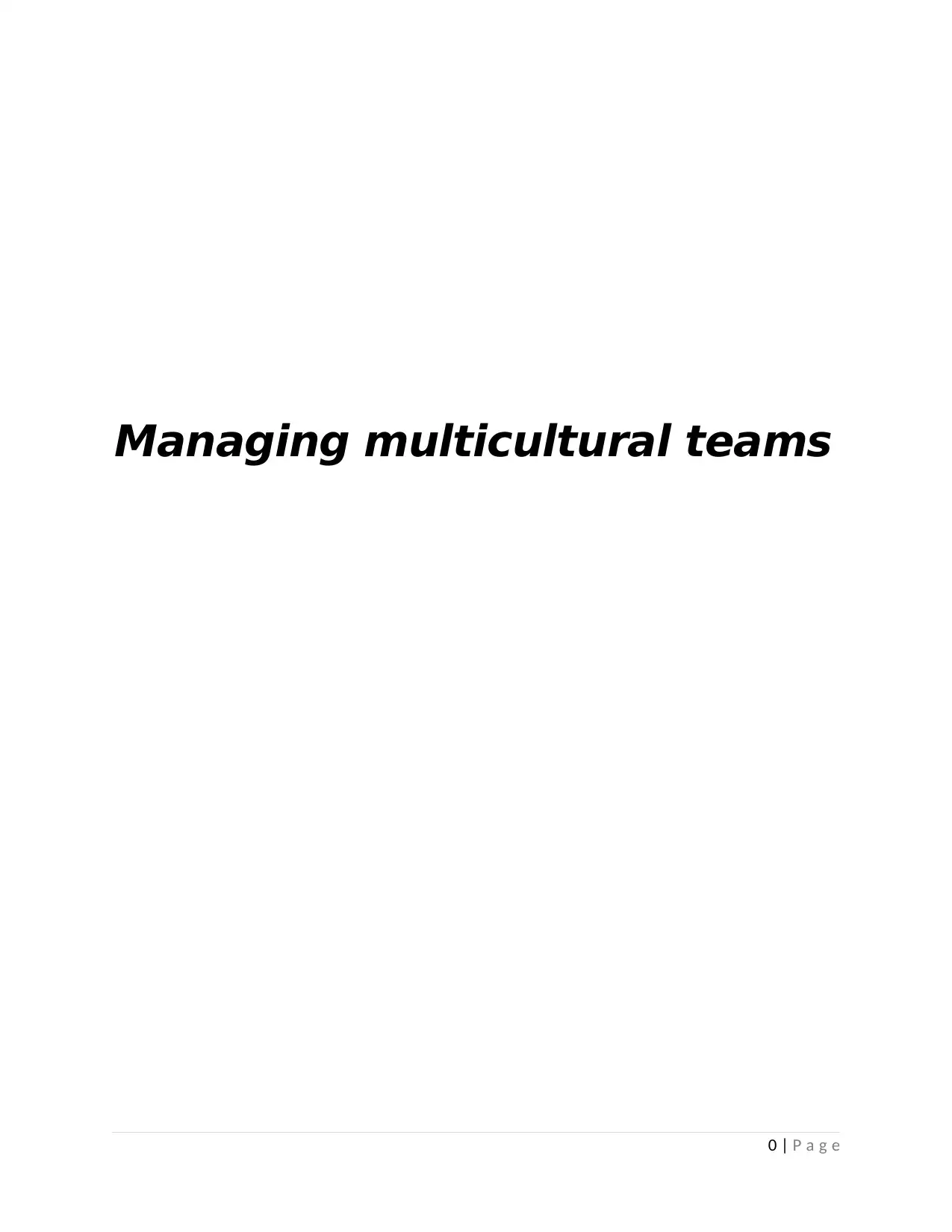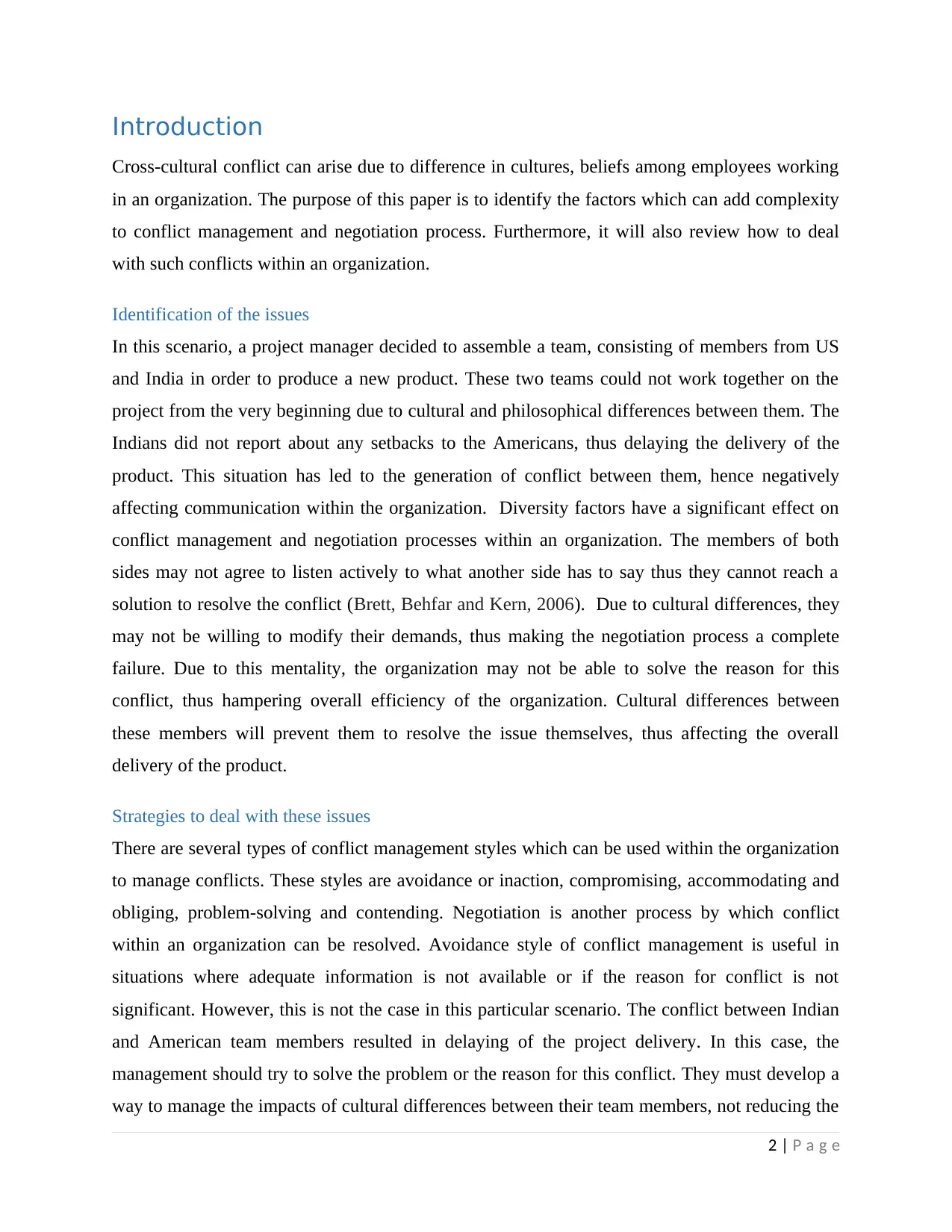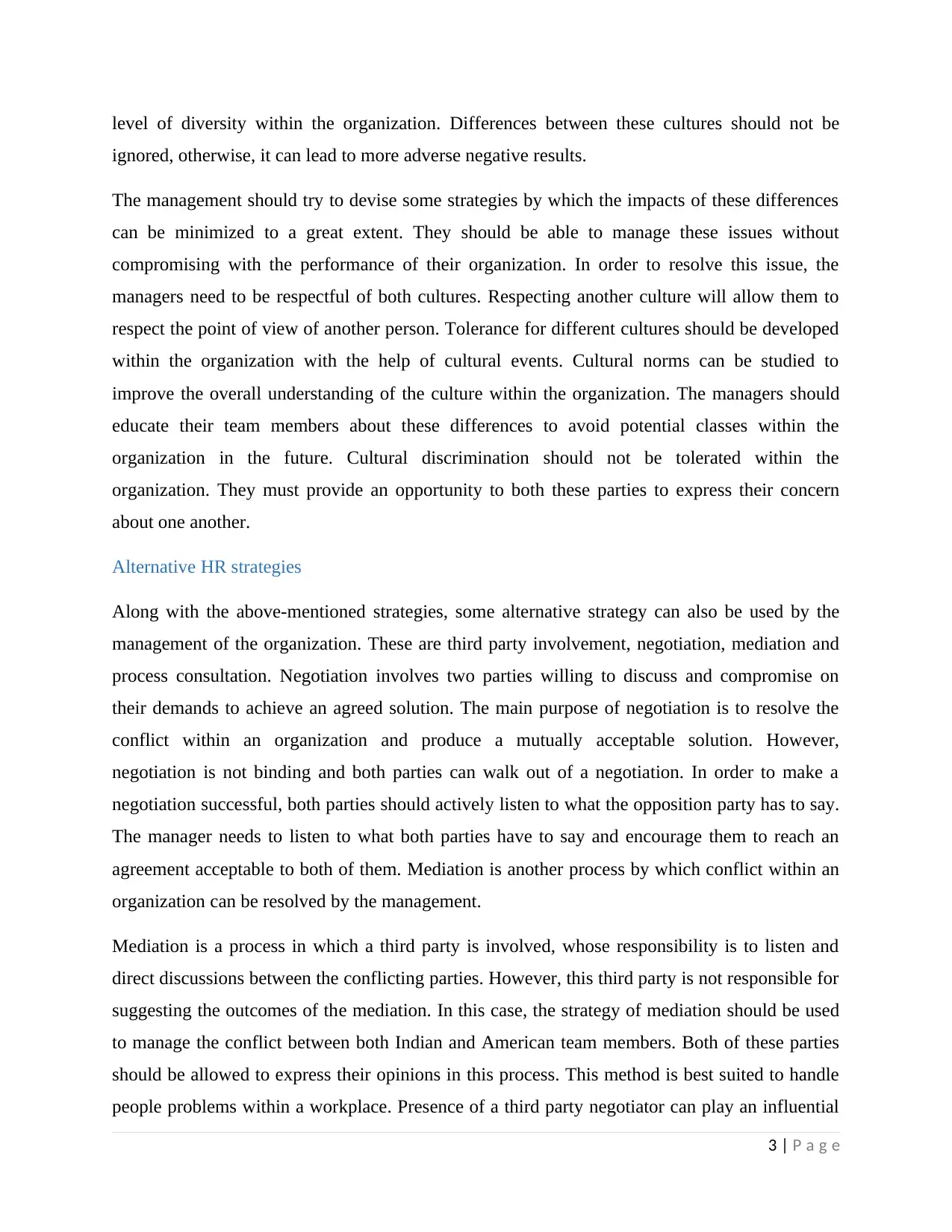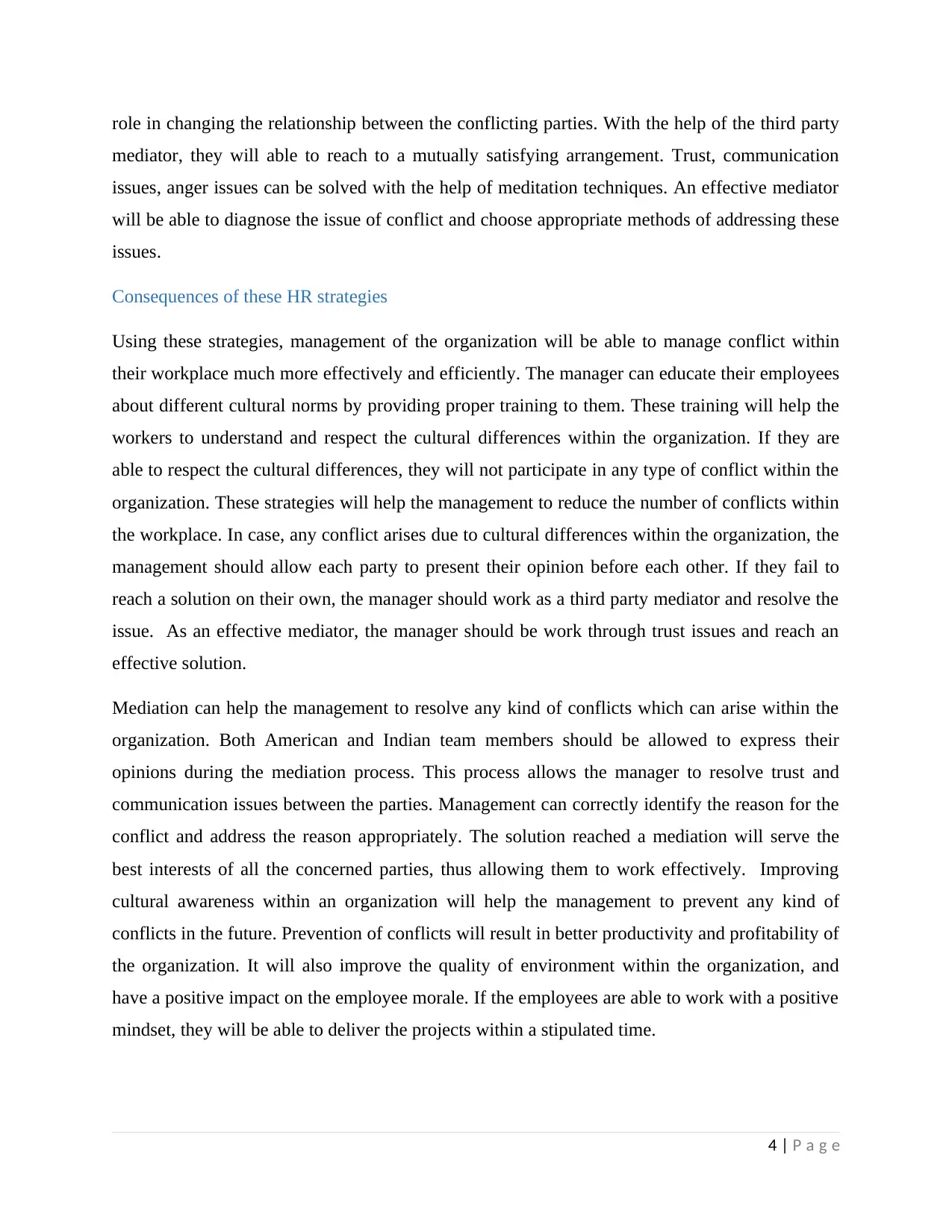Managing Conflict in Multicultural Teams: HR Strategies & Outcomes
VerifiedAdded on 2023/06/11
|7
|1410
|191
Report
AI Summary
This report identifies issues that add complexity to conflict management and negotiation processes within multicultural teams, specifically focusing on a scenario involving American and Indian team members. It explores strategies to address these issues, including various conflict management styles such as avoidance, compromising, and problem-solving. Alternative HR strategies like third-party involvement, negotiation, mediation, and process consultation are also discussed. The report further analyzes the consequences of these HR strategies, emphasizing the importance of cultural awareness and effective communication to prevent conflicts and improve team productivity. The conclusion highlights that diversity factors increase complexity but can be managed effectively with appropriate strategies, ultimately enhancing organizational performance and employee morale. Desklib offers more resources for students.

Managing multicultural teams
0 | P a g e
0 | P a g e
Paraphrase This Document
Need a fresh take? Get an instant paraphrase of this document with our AI Paraphraser

Table of Contents
Introduction.................................................................................................................................................2
Identification of the issues...........................................................................................................................2
Strategies to deal with these issues..............................................................................................................2
Alternative HR strategies.............................................................................................................................3
Consequences of these HR strategies..........................................................................................................4
Conclusion...................................................................................................................................................5
References...................................................................................................................................................6
1 | P a g e
Introduction.................................................................................................................................................2
Identification of the issues...........................................................................................................................2
Strategies to deal with these issues..............................................................................................................2
Alternative HR strategies.............................................................................................................................3
Consequences of these HR strategies..........................................................................................................4
Conclusion...................................................................................................................................................5
References...................................................................................................................................................6
1 | P a g e

Introduction
Cross-cultural conflict can arise due to difference in cultures, beliefs among employees working
in an organization. The purpose of this paper is to identify the factors which can add complexity
to conflict management and negotiation process. Furthermore, it will also review how to deal
with such conflicts within an organization.
Identification of the issues
In this scenario, a project manager decided to assemble a team, consisting of members from US
and India in order to produce a new product. These two teams could not work together on the
project from the very beginning due to cultural and philosophical differences between them. The
Indians did not report about any setbacks to the Americans, thus delaying the delivery of the
product. This situation has led to the generation of conflict between them, hence negatively
affecting communication within the organization. Diversity factors have a significant effect on
conflict management and negotiation processes within an organization. The members of both
sides may not agree to listen actively to what another side has to say thus they cannot reach a
solution to resolve the conflict (Brett, Behfar and Kern, 2006). Due to cultural differences, they
may not be willing to modify their demands, thus making the negotiation process a complete
failure. Due to this mentality, the organization may not be able to solve the reason for this
conflict, thus hampering overall efficiency of the organization. Cultural differences between
these members will prevent them to resolve the issue themselves, thus affecting the overall
delivery of the product.
Strategies to deal with these issues
There are several types of conflict management styles which can be used within the organization
to manage conflicts. These styles are avoidance or inaction, compromising, accommodating and
obliging, problem-solving and contending. Negotiation is another process by which conflict
within an organization can be resolved. Avoidance style of conflict management is useful in
situations where adequate information is not available or if the reason for conflict is not
significant. However, this is not the case in this particular scenario. The conflict between Indian
and American team members resulted in delaying of the project delivery. In this case, the
management should try to solve the problem or the reason for this conflict. They must develop a
way to manage the impacts of cultural differences between their team members, not reducing the
2 | P a g e
Cross-cultural conflict can arise due to difference in cultures, beliefs among employees working
in an organization. The purpose of this paper is to identify the factors which can add complexity
to conflict management and negotiation process. Furthermore, it will also review how to deal
with such conflicts within an organization.
Identification of the issues
In this scenario, a project manager decided to assemble a team, consisting of members from US
and India in order to produce a new product. These two teams could not work together on the
project from the very beginning due to cultural and philosophical differences between them. The
Indians did not report about any setbacks to the Americans, thus delaying the delivery of the
product. This situation has led to the generation of conflict between them, hence negatively
affecting communication within the organization. Diversity factors have a significant effect on
conflict management and negotiation processes within an organization. The members of both
sides may not agree to listen actively to what another side has to say thus they cannot reach a
solution to resolve the conflict (Brett, Behfar and Kern, 2006). Due to cultural differences, they
may not be willing to modify their demands, thus making the negotiation process a complete
failure. Due to this mentality, the organization may not be able to solve the reason for this
conflict, thus hampering overall efficiency of the organization. Cultural differences between
these members will prevent them to resolve the issue themselves, thus affecting the overall
delivery of the product.
Strategies to deal with these issues
There are several types of conflict management styles which can be used within the organization
to manage conflicts. These styles are avoidance or inaction, compromising, accommodating and
obliging, problem-solving and contending. Negotiation is another process by which conflict
within an organization can be resolved. Avoidance style of conflict management is useful in
situations where adequate information is not available or if the reason for conflict is not
significant. However, this is not the case in this particular scenario. The conflict between Indian
and American team members resulted in delaying of the project delivery. In this case, the
management should try to solve the problem or the reason for this conflict. They must develop a
way to manage the impacts of cultural differences between their team members, not reducing the
2 | P a g e
⊘ This is a preview!⊘
Do you want full access?
Subscribe today to unlock all pages.

Trusted by 1+ million students worldwide

level of diversity within the organization. Differences between these cultures should not be
ignored, otherwise, it can lead to more adverse negative results.
The management should try to devise some strategies by which the impacts of these differences
can be minimized to a great extent. They should be able to manage these issues without
compromising with the performance of their organization. In order to resolve this issue, the
managers need to be respectful of both cultures. Respecting another culture will allow them to
respect the point of view of another person. Tolerance for different cultures should be developed
within the organization with the help of cultural events. Cultural norms can be studied to
improve the overall understanding of the culture within the organization. The managers should
educate their team members about these differences to avoid potential classes within the
organization in the future. Cultural discrimination should not be tolerated within the
organization. They must provide an opportunity to both these parties to express their concern
about one another.
Alternative HR strategies
Along with the above-mentioned strategies, some alternative strategy can also be used by the
management of the organization. These are third party involvement, negotiation, mediation and
process consultation. Negotiation involves two parties willing to discuss and compromise on
their demands to achieve an agreed solution. The main purpose of negotiation is to resolve the
conflict within an organization and produce a mutually acceptable solution. However,
negotiation is not binding and both parties can walk out of a negotiation. In order to make a
negotiation successful, both parties should actively listen to what the opposition party has to say.
The manager needs to listen to what both parties have to say and encourage them to reach an
agreement acceptable to both of them. Mediation is another process by which conflict within an
organization can be resolved by the management.
Mediation is a process in which a third party is involved, whose responsibility is to listen and
direct discussions between the conflicting parties. However, this third party is not responsible for
suggesting the outcomes of the mediation. In this case, the strategy of mediation should be used
to manage the conflict between both Indian and American team members. Both of these parties
should be allowed to express their opinions in this process. This method is best suited to handle
people problems within a workplace. Presence of a third party negotiator can play an influential
3 | P a g e
ignored, otherwise, it can lead to more adverse negative results.
The management should try to devise some strategies by which the impacts of these differences
can be minimized to a great extent. They should be able to manage these issues without
compromising with the performance of their organization. In order to resolve this issue, the
managers need to be respectful of both cultures. Respecting another culture will allow them to
respect the point of view of another person. Tolerance for different cultures should be developed
within the organization with the help of cultural events. Cultural norms can be studied to
improve the overall understanding of the culture within the organization. The managers should
educate their team members about these differences to avoid potential classes within the
organization in the future. Cultural discrimination should not be tolerated within the
organization. They must provide an opportunity to both these parties to express their concern
about one another.
Alternative HR strategies
Along with the above-mentioned strategies, some alternative strategy can also be used by the
management of the organization. These are third party involvement, negotiation, mediation and
process consultation. Negotiation involves two parties willing to discuss and compromise on
their demands to achieve an agreed solution. The main purpose of negotiation is to resolve the
conflict within an organization and produce a mutually acceptable solution. However,
negotiation is not binding and both parties can walk out of a negotiation. In order to make a
negotiation successful, both parties should actively listen to what the opposition party has to say.
The manager needs to listen to what both parties have to say and encourage them to reach an
agreement acceptable to both of them. Mediation is another process by which conflict within an
organization can be resolved by the management.
Mediation is a process in which a third party is involved, whose responsibility is to listen and
direct discussions between the conflicting parties. However, this third party is not responsible for
suggesting the outcomes of the mediation. In this case, the strategy of mediation should be used
to manage the conflict between both Indian and American team members. Both of these parties
should be allowed to express their opinions in this process. This method is best suited to handle
people problems within a workplace. Presence of a third party negotiator can play an influential
3 | P a g e
Paraphrase This Document
Need a fresh take? Get an instant paraphrase of this document with our AI Paraphraser

role in changing the relationship between the conflicting parties. With the help of the third party
mediator, they will able to reach to a mutually satisfying arrangement. Trust, communication
issues, anger issues can be solved with the help of meditation techniques. An effective mediator
will be able to diagnose the issue of conflict and choose appropriate methods of addressing these
issues.
Consequences of these HR strategies
Using these strategies, management of the organization will be able to manage conflict within
their workplace much more effectively and efficiently. The manager can educate their employees
about different cultural norms by providing proper training to them. These training will help the
workers to understand and respect the cultural differences within the organization. If they are
able to respect the cultural differences, they will not participate in any type of conflict within the
organization. These strategies will help the management to reduce the number of conflicts within
the workplace. In case, any conflict arises due to cultural differences within the organization, the
management should allow each party to present their opinion before each other. If they fail to
reach a solution on their own, the manager should work as a third party mediator and resolve the
issue. As an effective mediator, the manager should be work through trust issues and reach an
effective solution.
Mediation can help the management to resolve any kind of conflicts which can arise within the
organization. Both American and Indian team members should be allowed to express their
opinions during the mediation process. This process allows the manager to resolve trust and
communication issues between the parties. Management can correctly identify the reason for the
conflict and address the reason appropriately. The solution reached a mediation will serve the
best interests of all the concerned parties, thus allowing them to work effectively. Improving
cultural awareness within an organization will help the management to prevent any kind of
conflicts in the future. Prevention of conflicts will result in better productivity and profitability of
the organization. It will also improve the quality of environment within the organization, and
have a positive impact on the employee morale. If the employees are able to work with a positive
mindset, they will be able to deliver the projects within a stipulated time.
4 | P a g e
mediator, they will able to reach to a mutually satisfying arrangement. Trust, communication
issues, anger issues can be solved with the help of meditation techniques. An effective mediator
will be able to diagnose the issue of conflict and choose appropriate methods of addressing these
issues.
Consequences of these HR strategies
Using these strategies, management of the organization will be able to manage conflict within
their workplace much more effectively and efficiently. The manager can educate their employees
about different cultural norms by providing proper training to them. These training will help the
workers to understand and respect the cultural differences within the organization. If they are
able to respect the cultural differences, they will not participate in any type of conflict within the
organization. These strategies will help the management to reduce the number of conflicts within
the workplace. In case, any conflict arises due to cultural differences within the organization, the
management should allow each party to present their opinion before each other. If they fail to
reach a solution on their own, the manager should work as a third party mediator and resolve the
issue. As an effective mediator, the manager should be work through trust issues and reach an
effective solution.
Mediation can help the management to resolve any kind of conflicts which can arise within the
organization. Both American and Indian team members should be allowed to express their
opinions during the mediation process. This process allows the manager to resolve trust and
communication issues between the parties. Management can correctly identify the reason for the
conflict and address the reason appropriately. The solution reached a mediation will serve the
best interests of all the concerned parties, thus allowing them to work effectively. Improving
cultural awareness within an organization will help the management to prevent any kind of
conflicts in the future. Prevention of conflicts will result in better productivity and profitability of
the organization. It will also improve the quality of environment within the organization, and
have a positive impact on the employee morale. If the employees are able to work with a positive
mindset, they will be able to deliver the projects within a stipulated time.
4 | P a g e

Conclusion
The paper concludes that diversity factors add a certain level of complexity to conflict
management and negotiation processes within the organization. However, there are certain
strategies which can be used to deal with this issue and effectively manage a culturally diverse
team within a firm.
5 | P a g e
The paper concludes that diversity factors add a certain level of complexity to conflict
management and negotiation processes within the organization. However, there are certain
strategies which can be used to deal with this issue and effectively manage a culturally diverse
team within a firm.
5 | P a g e
⊘ This is a preview!⊘
Do you want full access?
Subscribe today to unlock all pages.

Trusted by 1+ million students worldwide

References
Brett, J., Behfar, K. and Kern, M.C., (2006). Managing multicultural teams. Harvard business
review, 84(11), November, pp, 84-6.
6 | P a g e
Brett, J., Behfar, K. and Kern, M.C., (2006). Managing multicultural teams. Harvard business
review, 84(11), November, pp, 84-6.
6 | P a g e
1 out of 7
Related Documents
Your All-in-One AI-Powered Toolkit for Academic Success.
+13062052269
info@desklib.com
Available 24*7 on WhatsApp / Email
![[object Object]](/_next/static/media/star-bottom.7253800d.svg)
Unlock your academic potential
Copyright © 2020–2025 A2Z Services. All Rights Reserved. Developed and managed by ZUCOL.




